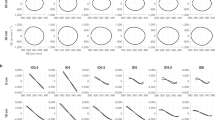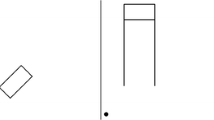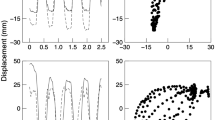Abstract
A crew of two rowing together in perfect synchrony is an example of a task that requires each performer to maintain meticulous timing when coordinating their movements with the other. At the individual level, temporal coordination of the limbs has been observed in bimanual pointing movements even when made to targets of different distance. Timing of the arms is not independent; rather there is a natural temporal coupling. The aim of this experiment was to investigate whether the temporal characteristics of pointing movements can be observed under joint conditions. Sixteen pairs of participants made short and long, unimanual and bimanual pointing movements. In the unimanual and bimanual solo conditions, participants made the movements alone. In the joint condition, each participant contributed one arm to the joint “bimanual” movements. Absolute temporal coupling at movement initiation and termination was measured by the differences in reaction time and total response time. Relative temporal coupling at movement initiation and termination was measured by correlating reaction time and total response time of the left and right limbs. Pointing movements had synchronous movement termination in the bimanual solo conditions and asynchronous termination in the unimanual solo and bimanual joint conditions. The initiation and termination of the arms were not correlated in the unimanual solo condition (initiation r = 0.01, termination r = 0.03). Small-to-medium correlations (r = 0.19, r = 0.24) were observed in the bimanual joint condition, and they were larger than the unimanual solo condition (p = 0.022, p = 0.063). As expected, there were large correlations in the bimanual solo conditions (r = 0.91, r = 0.81). Our findings suggest that absolute temporal coupling does not occur between individuals, but there is evidence for relative temporal coupling in the bimanual joint condition.




Similar content being viewed by others
Notes
Our thanks to two anonymous reviewers for raising this issue.
References
Ansorge U, Wühr P (2004) A response-discrimination account of the Simon effect. J Exp Psychol Hum Percept Perform 30(2):365–377. https://doi.org/10.1037/0096-1523.30.2.365
Atkinson MA, Simpson A, Skarratt PA, Cole GG (2014) Is social inhibition of return due to action co-representation? Acta Psychol 150:85–93. https://doi.org/10.1016/j.actpsy.2014.04.003
Atmaca S, Sebanz N, Prinz W, Knoblich G (2008) Action co-representation: the joint SNARC effect. Soc Neurosci 3(3–4):410–420. https://doi.org/10.1080/17470910801900908
Baudouin A, Hawkins D (2004) Investigation of biomechanical factors affecting rowing performance. J Biomech 37(7):969–976
Blinch J, Cameron BD, Cressman EK, Franks IM, Carpenter MG, Chua R (2014) Comparing movement preparation of unimanual, bimanual symmetric, and bimanual asymmetric movements. Exp Brain Res 232(3):947–955. https://doi.org/10.1007/s00221-013-3807-7
Coey CA, Varlet M, Schmidt RC, Richardson MJ (2011) Effects of movement stability and congruency on the emergence of spontaneous interpersonal coordination. Exp Brain Res 211:483–493
Cousineau D (2005) Confidence intervals in within-subject designs: a simpler solution to Loftus and Masson’s method. Tutor Quant Methods Psychol 1:42–45
Cuijpers LS, Zaal FT, de Poel HJ (2015) Rowing crew coordination dynamics at increasing stroke rates. PLoS One 10(7):e0133527. https://doi.org/10.1371/journal.pone.0133527
de Bruijn ER, Miedl SF, Bekkering H (2008) Fast responders have blinders on: ERP correlates of response inhibition in competition. Cortex 44(5):580–586. https://doi.org/10.1016/j.cortex.2007.09.003
della Gatta F, Garbarini F, Rabuffetti M, Viganò L, Butterfill SA, Sinigaglia C (2017) Drawn together: when motor representations ground joint actions. Cognition 165:53–60. https://doi.org/10.1016/j.cognition.2017.04.008
Fine JM, Amazeen EL (2011) Interpersonal Fitts’ law: when two perform as one. Exp Brain Res 211(3–4):459–469. https://doi.org/10.1007/s00221-011-2707-y
Fitts PM (1954) The information capacity of the human motor system in controlling the amplitude of movement. J Exp Psychol 47(6):381–391
Franz EA, Zelaznik HN, McCabe G (1991) Spatial topological constraints in a bimanual task. Acta Psychol 77(2):137–151
Huynh H, Feldt LS (1976) Estimation of the Box correction for degrees of freedom from sample data in randomized block and split-plot designs. J Educ Stat 1(1):69–82
Jung C, Holländer A, Müller K, Prinz W (2011) Sharing a bimanual task between two: evidence of temporal alignment in interpersonal coordination. Exp Brain Res 211(3–4):471–482 https://doi.org/10.1007/s00221-011-2665-4
Kelso JS, Southard DL, Goodman D (1979) On the nature of human interlimb coordination. Science 203(4384):1029–1031
Konvalinka I, Vuust P, Roepstorff A, Frith CD (2010) Follow you, follow me: continuous mutual prediction and adaptation in joint tapping. Q J Exp Psychol 63(11):2220–2230 https://doi.org/10.1080/17470218.2010.497843
Lam MY (2013) Modulation of joint action correspondence effects by task context: examination of the contributions of social, spatial, and response discrimination factors (Doctoral Thesis). https://open.library.ubc.ca/cIRcle/collections/ubctheses/24/items/1.0073554
Liepelt R, Wenke D, Fischer R, Prinz W (2011) Trial-to-trial sequential dependencies in a social and non-social Simon task. Psychol Res 75(5):366–375
Marteniuk RG, MacKenzie CL, Baba DM (1984) Bimanual movement control: Information processing and interaction effects. Q J Exp Psychol A 36(2):335–365
Morey RD (2008) Confidence intervals from normalized data: a correction to Cousineau (2005). Tutor Quant Methods Psychol 4(2):61–64 http://dx.doi.org/ https://doi.org/10.3758/s13428-013-0441-z
Newman-Norlund RD, Bosga J, Meulenbroek RG, Bekkering H (2008) Anatomical substrates of cooperative joint-action in a continuous motor task: virtual lifting and balancing. Neuroimage 41(1):169–177. https://doi.org/10.1016/j.neuroimage.2008.02.026
Oullier O, De Guzman GC, Jantzen KJ, Lagarde J, Scott Kelso JA (2008) Social coordination dynamics: measuring human bonding. Soc Neurosci 3(2):178–192. https://doi.org/10.1080/17470910701563392
Richardson MJ, Marsh KL, Schmidt RC (2005) Effects of visual and verbal interaction on unintentional interpersonal coordination. J Exp Psychol Hum Percept Perform 31(1):62–79. https://doi.org/10.1037/0096-1523.31.1.62
Richardson MJ, Lopresti-Goodman S, Mancini M, Kay B, Schmidt RC (2008) Comparing the attractor strength of intra- and interpersonal interlimb coordination using cross-recurrence analysis. Neurosci Lett 438:340–345
Riley MA, Richardson M, Shockley K, Ramenzoni VC (2011) Interpersonal synergies. Front Psychol 2(38):1–7. https://doi.org/10.3389/fpsyg.2011.00038
Schmidt RC, Carello C, Turvey MT (1990) Phase transitions and critical fluctuations in the visual coordination of rhythmic movements between people. J Exp Psychol Hum Percept Perform 16(2):227–247
Schmidt RC, O’Brien B (1997) Evaluating the dynamics of unintended interpersonal coordination. Ecol Psychol 9(3):189–206. https://doi.org/10.1207/s15326969eco0903_2
Schmidt RC, Bienvenu M, Fitzpatrick PA, Amazeen PG (1998) A comparison of intra- and interpersonal interlimb coordination: coordination breakdowns and coupling strength. J Exp Psychol Hum Percept Perform 24(3):884–900. https://doi.org/10.1037//0096-1523.24.3.884
Sebanz N, Knoblich G, Prinz W (2003) Representing others’ actions: just like one’s own? Cognition 88(3):B11–B21 https://doi.org/10.1016/S0010-0277(03)00043-X
Sebanz N, Bekkering H, Knoblich G (2006) Joint action: bodies and minds moving together. Trends Cogn Sci 10(2):70–76. https://doi.org/10.1016/j.tics.2005.12.009
Tsai CC, Kuo WJ, Hung DL, Tzeng OJ (2008) Action co-representation is tuned to other humans. J Cognitive Neurosci 20(11):2015–2024. https://doi.org/10.1162/jocn.2008.20144
van Ulzen NR, Lamoth CJ, Daffertshofer A, Semin GR, Beek PJ (2008) Characteristics of instructed and uninstructed interpersonal coordination while walking side-by-side. Neurosci Lett 432(2):88–93. https://doi.org/10.1016/j.neulet.2007.11.070
Vesper C, Soutschek A, Schubö A (2009) Motion coordination affects movement parameters in a joint pick-and-place task. Q J Exp Psychol 62(12):2418–2432. https://doi.org/10.1080/17470210902919067
Vlainic E, Liepelt R, Colzato LS, Prinz W, Hommel B (2010) The virtual co-actor: the social Simon effect does not rely on online feedback from the other. Front Psychol 1:1–6. https://doi.org/10.3389/fpsyg.2010.00208
Welsh TN, Higgins L, Ray M, Weeks DJ (2007) Seeing vs. believing: is believing sufficient to activate the processes of response co-representation? Hum Movement Sci 26(6):853–866. https://doi.org/10.1016/j.humov.2007.06.003
Williams JGP (1967) Some biomechanical aspects of rowing. In: Williams JPG, Scott AC (eds) Rowing: a scientific approach. Kaye & Ward, London, pp 81–109
Wing AM, Woodburn C (1995) The coordination and consistency of rowers in a racing eight. J Sports Sci 13(3):187–197
Acknowledgements
The Natural Sciences and Engineering Research Council of Canada supported this research with a Tier II Canada Research Chair and a Discovery Grant awarded to Claudia Gonzalez.
Funding
The Natural Sciences and Engineering Research Council of Canada supported this research with a Tier II Canada Research Chair and a Discovery Grant (NSERC Fund #14367) awarded to Claudia Gonzalez.
Author information
Authors and Affiliations
Corresponding author
Ethics declarations
Conflict of interest
The authors declare that they have no conflict of interest.
Ethical approval
All procedures performed in studies involving human participants were in accordance with the ethical standards of the institutional and/or national research committee and with the 1964 Helsinki declaration and its later amendments or comparable ethical standards.
Informed consent
Informed consent was obtained from all individual participants included in the study.
Rights and permissions
About this article
Cite this article
Lam, M.Y., Blinch, J., Connors, E.M. et al. Bimanual joint action: correlated timing or “bimanual” movements accomplished by two people. Exp Brain Res 236, 2363–2375 (2018). https://doi.org/10.1007/s00221-018-5306-3
Received:
Accepted:
Published:
Issue Date:
DOI: https://doi.org/10.1007/s00221-018-5306-3




